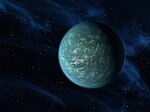astro.wikisort.org - Galaxy
UDFj-39546284 is the designation given to a stellar structure reported on January 27, 2011,[6] as light from the oldest object detected through infrared[7] observation within the Hubble Space Telescope. The object, located in the Fornax constellation, was identified by G. Illingworth (UC Santa Cruz), R. Bouwens (UC Santa Cruz and Leiden University) and the HUDF09 Team during 2009 and 2010.[8][9] It was initially thought (November 2012) to be at redshift z~10 using Hubble and Spitzer telescope photometric data, including Hubble Extreme Deep Field (XDF).[4] Subsequently, it was reported (December 2012) to possibly be at a record-breaking redshift z = 11.9[3] using Hubble and Spitzer telescope data, including Hubble Ultra-Deep Field (HUDF).[3][4] Recent analyses (March 2013) have suggested this source is more likely to be a low redshift interloper, with extreme emission lines in its spectrum producing the appearance of a very high redshift source.[5][4]
| UDFj-39546284 | |
|---|---|
 Hubble Space Telescope image of UDFj-39546284 (seen as a reddish spot in the center of the image) | |
| Observation data (J2000 epoch) | |
| Constellation | Fornax |
| Right ascension | 03h 32m 39.54s[1] |
| Declination | −27° 46′ 28.5″[1] |
| Redshift | uncertain[2] [4][5] |
| Apparent magnitude (V) | V fainter than 30.1[2] H160 = 28.92 ± 0.18[2] J125 – H160 > 2[2] |
| Other designations | |
| [MDB2013] UDF12-3954-6285 | |
Gallery
 UDFj-39546284
UDFj-39546284 UDFj-39546284 appears as a faint red blob
UDFj-39546284 appears as a faint red blob
See also
- EGSY8p7
- Hubble Ultra-Deep Field
- List of the most distant astronomical objects
- MACS0647-JD
- Reionization
- UDFy-38135539
References
- "[MDB2013] UDF12-3954-6284". SIMBAD. Centre de données astronomiques de Strasbourg. Retrieved 2021-02-13.
- R.J. Bouwens; G.D. Illingworth; I. Labbe; P.A. Oesch; M. Carollo; M. Trenti; P.G. van Dokkum; M. Franx; M. Stiavelli; V. Gonzalez; D. Magee; Bradley (2011). "A candidate redshift z ~ 10 galaxy and rapid changes in that population at an age of 500 Myr". Nature. 469 (7331): 504–507. arXiv:0912.4263. Bibcode:2011Natur.469..504B. doi:10.1038/nature09717. PMID 21270889.
- Wall, Mike (December 12, 2012). "Ancient Galaxy May Be Most Distant Ever Seen". Space.com. Retrieved December 12, 2012.
- Bouwens, R. J.; Oesch, P. A.; Illingworth, G. D.; Labbé, I.; Van Dokkum, P. G.; Brammer, G.; Magee, D.; Spitler, L. R.; Franx, M.; Smit, R.; Trenti, M.; Gonzalez, V.; Carollo, C. M. (2013). "Photometric Constraints on the Redshift of z ~ 10 Candidate UDFj-39546284 from Deeper WFC3/IR+ACS+IRAC Observations over the HUDF". The Astrophysical Journal Letters. 765 (1): L16. arXiv:1211.3105. Bibcode:2013ApJ...765L..16B. doi:10.1088/2041-8205/765/1/L16.
- Brammer, Gabriel B.; Van Dokkum, Pieter G.; Illingworth, Garth D.; Bouwens, Rychard J.; Labbé, Ivo; Franx, Marijn; Momcheva, Ivelina; Oesch, Pascal A. (2013). "A Tentative Detection of an Emission Line at 1.6 μm for the z ~ 12 Candidate UDFj-39546284". The Astrophysical Journal Letters. 765 (1): L2. arXiv:1301.0317. Bibcode:2013ApJ...765L...2B. doi:10.1088/2041-8205/765/1/L2.
- C Petit writing for Knight Science Journalism at MIT - tracker Retrieved 2012-08-10
- A Mann writing for a Nature magazine (online) article Retrieved 2012-08-10 – this article references – Bouwens, R. J. et al. Nature 469, 504–507 (2011). 2.Yan, H.-J. et al. Res. Astron. Astrophys. 10, 867–904 (2010). 3.Kistler, M. D., Yüksel, H., Beacom, J. F., Hopkins, A. M. & Wyithe, J. S. B. Astrophys. J. 705, L104-L108 (2009)
- Staff (January 28, 2011). "Most Distant Galaxy Candidate Ever Seen in Universe". NASA. Retrieved December 13, 2012.
- Staff. "Picture Album: Gray-scale Image of Object UDFj-39546284 from HUDF WFC3/IR". Space Telescope Science Institute. Retrieved December 13, 2012.
External links
| Wikimedia Commons has media related to UDFj-39546284. |
На других языках
[de] UDFj-39546284
UDFj-39546284 ist ein Kandidat für eine Galaxie mit einer Rotverschiebung von z~10. Sie ist damit, zum Zeitpunkt ihrer Entdeckung im Januar 2011, das wahrscheinlich entfernteste bekannte Objekt im Universum. Die Galaxie ist im Hubble Ultra Deep Field im Infrarot-Bereich entdeckt worden.- [en] UDFj-39546284
[es] UDFj-39546284
UDFj-39546284 era una galaxia compacta de estrellas azules que existía hace 13.200 millones de años, alrededor de escasamente 480 millones de años después del Big Bang. Es la galaxia más lejana (y más antigua) observada hasta el 26 de enero de 2011, superando a la anterior poseedora del récord como objeto astronómico más distante por aproximadamente 150 millones de años luz; únicamente la galaxia gnz11 a 13400 millones de años luz y la radiación de fondo de microondas se encuentra más lejos.[ru] UDFj-39546284
UDFj-39546284 — компактная галактика, состоящая из голубых звёзд, которые существовали 13,4 миллиарда лет назад, то есть примерно через 380 миллионов лет после Большого взрыва. Это одна из самых далёких обнаруженных галактик.Другой контент может иметь иную лицензию. Перед использованием материалов сайта WikiSort.org внимательно изучите правила лицензирования конкретных элементов наполнения сайта.
WikiSort.org - проект по пересортировке и дополнению контента Википедии




